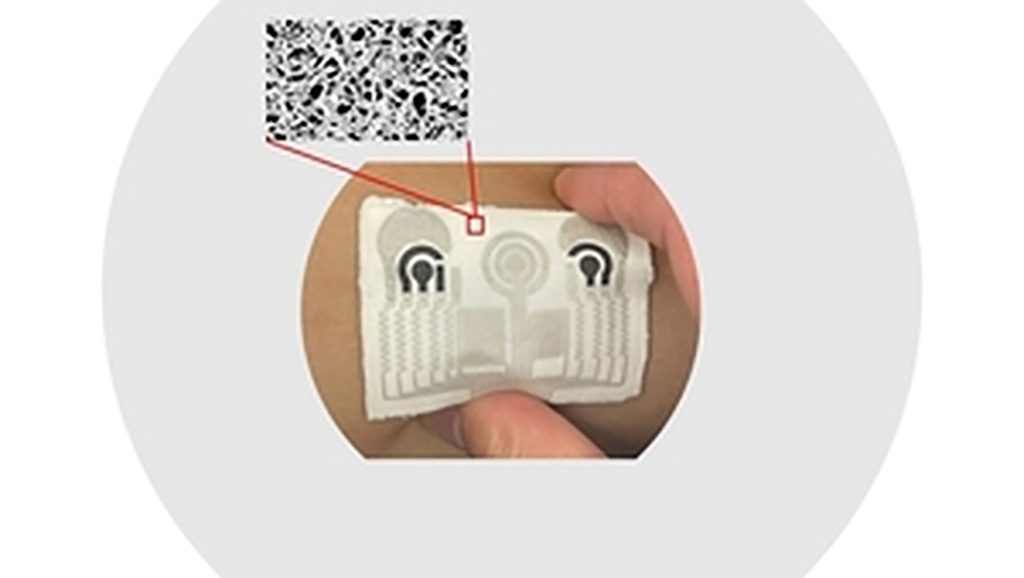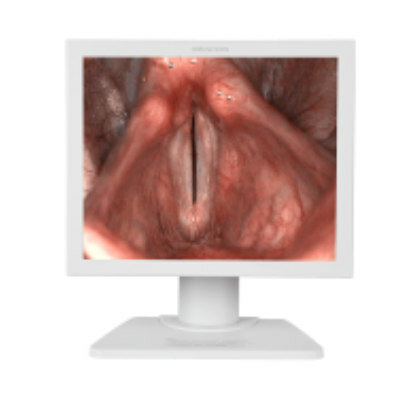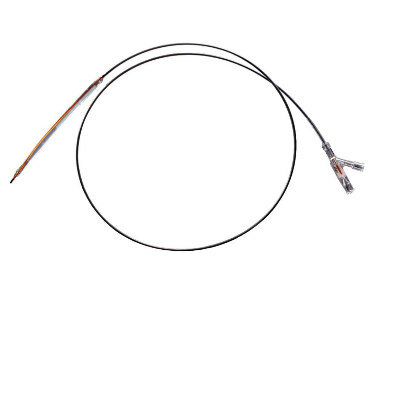First-of-Its-Kind Electronic Skin Patch Enables Advanced Health Care Monitoring
|
By HospiMedica International staff writers Posted on 31 Jan 2023 |

For some time now, electronic skin (E-skin) patches have been used to monitor bodily physiological and chemical indicators of health. Such monitors, placed on the skin, are capable of measuring various parameters like body motions and temperature, skin hydration, different metabolic biomarkers, and brain and heart functionality (via electrocardiograms and electroencephalograms). A skin-sensing patch usually consists of a sensor layer, which converts physical information into electrical signals, positioned on top of a flexible, stretchable substrate layer that rests on the skin and is resistant to mechanical deformation. However, most current substrates have mechanical and biological incompatibilities along with poor breathability, thereby hampering multi-sensing ability and resulting in skin irritation and inflammation, particularly after long-term use. Additionally, most current substrates cannot be recycled or disposed off in an environmentally friendly manner.
Now, scientists from the Terasaki Institute (Los Angeles, CA, USA) have addressed these problems by using a novel gelatin-based, highly porous substrate to devise a first-of-its-kind E-skin patch for advanced healthcare monitoring. Using an optimum choice in materials and a novel fabrication method, the E-skin patch provides simultaneous, continuous monitoring of multiple bodily parameters, along with providing temperature-moisture management and breathability. By opting for gelatin methacryloyl (GelMA) to fabricate their substrate, the researchers managed to meet the need for biocompatibility, biodegradation, self-adhesion, and tissue-like mechanical properties.
However, the need for breathability and moisture control still posed a challenge. It was possible to achieve permeability in GelMA by rendering it into a porous aerogel form, although the resultant aerogel was brittle, making it unsuitable for skin-sensing substrates. The TIBI researchers resolved this issue by carefully examining the effects of cryofreezing on GelMA flexibility and using their understanding to develop a novel method for overcoming the brittleness of GelMA aerogels. Their method led to the creation of a GelMA aerogel that is flexible, breathable, ultralight, and moisture/air-permeable, on account of its highly uniform and interconnected pores and their potential for three-dimensional capillary action. The substrate’s enhanced capabilities also allowed the researchers to screen-print integrated multifunctional sensors onto the substrate, which could then be placed on the skin to simultaneously stimulate sweat excretion and extraction of interstitial fluid just below the surface of the skin. This enables continuous and multifunctional monitoring of bodily parameters like skin temperature and hydration levels, electro-cardiac measurements, and metabolic markers such as glucose, alcohol, and lactic acid.
The researchers validated these functions by using the new E-skin patch in a series of tests measuring the effects of glucose and alcohol-containing diets on subjects performing strenuous exercise. A comparison of the results against various individual commercial measurement devices showed that there was a good correlation. The researchers conducted further tests that validated the new E-skin’s superior flexibility, thermal cooling abilities, and fluid absorption over conventional brittle aerogel substrates, and also demonstrated excellent biocompatibility and biodegradation without any skin irritation. Additionally, the E-skin is biodegradable, thus eliminating the need for environmentally harmful waste disposal. Such an innovative multi-sensing device can provide a more accurate, real-time patient physiological profile. It will also be particularly beneficial for patients having several interrelated health conditions, like those with insulin-dependent diabetes who are prone to severe effects from glucose and alcohol and need to closely monitor their consumption. The E-skin can also find other applications by using different approaches, such as integrating additional simultaneous physiological measurements, coupling with drug delivery systems for therapeutic indications, and incorporating a wireless system for increasing convenience for patients.
“The advancements described here pave the way for producing next-generation electronic skin devices,” said Ali Khademhosseini, Ph.D., TIBI’s Director, and CEO. “They will be valuable tools in healthcare management, offering the best in accurate, real-time monitoring for real-life situations.”
Related Links:
Terasaki Institute
Latest Critical Care News
- Ingestible Capsule Monitors Intestinal Inflammation
- Wireless Implantable Sensor Enables Continuous Endoleak Monitoring
- Pulse Oximeter Index Offers Non-Invasive Guides for Fluid Therapy
- Wearable Patch for Early Skin Cancer Detection to Reduce Unnecessary Biopsies
- 'Universal' Kidney to Match Any Blood Type
- Light-Based Technology to Measure Brain Blood Flow Could Diagnose Stroke and TBI
- AI Heart Attack Risk Assessment Tool Outperforms Existing Methods
- Smartphone Imaging System Enables Early Oral Cancer Detection
- Swallowable Pill-Sized Bioprinter Treats GI Tract Injuries

- Personalized Brain “Pacemakers” Could Help Patients with Hard-To-Treat Epilepsy
- Microscopic DNA Flower Robots to Enable Precision Medicine Delivery
- Origami Robots to Deliver Medicine Less Invasively and More Effectively
- Improved Cough-Detection Technology Aids Health Monitoring
- AI Identifies Children in ER Likely to Develop Sepsis Within 48 Hours
- New Radiofrequency Therapy Slows Glioblastoma Growth
- Battery-Free Wireless Multi-Sensing Platform Revolutionizes Pressure Injury Detection
Channels
Surgical Techniques
view channel
Robotic Assistant Delivers Ultra-Precision Injections with Rapid Setup Times
Age-related macular degeneration (AMD) is a leading cause of blindness worldwide, affecting nearly 200 million people, a figure expected to rise to 280 million by 2040. Current treatment involves doctors... Read more
Minimally Invasive Endoscopic Surgery Improves Severe Stroke Outcomes
Intracerebral hemorrhage, a type of stroke caused by bleeding deep within the brain, remains one of the most challenging neurological emergencies to treat. Accounting for about 15% of all strokes, it carries... Read morePatient Care
view channel
Revolutionary Automatic IV-Line Flushing Device to Enhance Infusion Care
More than 80% of in-hospital patients receive intravenous (IV) therapy. Every dose of IV medicine delivered in a small volume (<250 mL) infusion bag should be followed by subsequent flushing to ensure... Read more
VR Training Tool Combats Contamination of Portable Medical Equipment
Healthcare-associated infections (HAIs) impact one in every 31 patients, cause nearly 100,000 deaths each year, and cost USD 28.4 billion in direct medical expenses. Notably, up to 75% of these infections... Read more
Portable Biosensor Platform to Reduce Hospital-Acquired Infections
Approximately 4 million patients in the European Union acquire healthcare-associated infections (HAIs) or nosocomial infections each year, with around 37,000 deaths directly resulting from these infections,... Read moreFirst-Of-Its-Kind Portable Germicidal Light Technology Disinfects High-Touch Clinical Surfaces in Seconds
Reducing healthcare-acquired infections (HAIs) remains a pressing issue within global healthcare systems. In the United States alone, 1.7 million patients contract HAIs annually, leading to approximately... Read moreHealth IT
view channel
Printable Molecule-Selective Nanoparticles Enable Mass Production of Wearable Biosensors
The future of medicine is likely to focus on the personalization of healthcare—understanding exactly what an individual requires and delivering the appropriate combination of nutrients, metabolites, and... Read moreBusiness
view channel
Philips and Masimo Partner to Advance Patient Monitoring Measurement Technologies
Royal Philips (Amsterdam, Netherlands) and Masimo (Irvine, California, USA) have renewed their multi-year strategic collaboration, combining Philips’ expertise in patient monitoring with Masimo’s noninvasive... Read more
B. Braun Acquires Digital Microsurgery Company True Digital Surgery
The high-end microsurgery market in neurosurgery, spine, and ENT is undergoing a significant transformation. Traditional analog microscopes are giving way to digital exoscopes, which provide improved visualization,... Read more
CMEF 2025 to Promote Holistic and High-Quality Development of Medical and Health Industry
The 92nd China International Medical Equipment Fair (CMEF 2025) Autumn Exhibition is scheduled to be held from September 26 to 29 at the China Import and Export Fair Complex (Canton Fair Complex) in Guangzhou.... Read more













